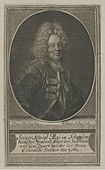Johann Georg Wolfgang
Johann Georg Wolfgang (* 1662 in Augsburg ; † December 21, 1744 in Berlin ) was an engraver in the Prussian service.
Life
Wolfgang was the son of Georg Andreas Wolfgang (1631–1716), who was born in Chemnitz and was a copper engraver in Augsburg. He married Maria Barbara Lomer in 1696. The marriage resulted in at least one son Georg Andreas (* 1703 in Augsburg), who hired himself as a portrait painter in his hometown and finally became court painter at Gotha through a job in England .
Together with his brother Andreas Matthaeus († 1736) he first learned the black art from his father . Both went to Amsterdam in 1684 for further training . On their return from an excursion to England, they were captured by Algerian corsairs and taken to Algiers as slaves . They were only able to return to Augsburg after they paid a ransom that their father raised. Until his marriage, Johann Georg worked in his father's workshop.
Together with Elias Christoph Heiß , who also came from Augsburg, Wolfgang was appointed royal Prussian court engraver in 1704 with a patent from February 19. At the royal court in Kleve he was commissioned to work at the newly established Academy of Arts and Sciences in Berlin and to depict the coronation of Frederick I of Prussia in a series of engravings. After initial economic difficulties, he was granted an annual grant of 200 Thalers on June 29, 1705 . In other respects, too, he received significant support from his employer. Wolfgang served under three Prussian kings, he stayed in Berlin until his death.
style
Wolfgang initially tried to orientate himself on the work of Gérard Edelinck . In general, he tried for a long time to copy the French masters. His particular strength lay in the elaboration of the face, here he used the greatest care. However, he did not succeed in achieving the contrast of his role models and so his oeuvre also shows a qualitative range. However, he was particularly successful with women's faces, or faces with soft features. In any case, he stands out from the crowd and the mediocrity of the German engravers of his time, even if he was not counted among the great masters of his field.
plant
The collaborative work with Jacob Müller to illustrate the symbolography of Jacobus Boschius is named as the most important work from the Augsburg period .
His highlighted works also include a Christ on the cross based on a model by Charles Le Brun and an equestrian statue of the Great Elector based on a model by Johann Jacobi .
One of his first works from the Berlin time was a large copper engraving of the statue of the Great Elector after Andreas Schlueter . In 1712 his 20 copper plates The Royal Prussian Coronation Hochfeÿerliche Solemnitäten , with texts by Johann von Besser, appeared .
For Queen Sophie Charlotte he illustrated her writing calendar as well as her obituary with copper.
In Dresden Royal Cabinet of Prints are 26 made by him stitches 1718/1719 for templates of Johann Samuel Mock emerged.
Through his work at the Prussian court, he had ample opportunity to portray members of the royal family, the court state and public life. Are mentioned u. a. Portraits of Georg Friedrich Handel , August Hermann Francke or Joachim Ernst von Grumbkow .
Some portraits based on models by Antoine Pesne are among his outstanding masterpieces :
Baroness Katharina Elisabeth von Chwałkowsky (1700–1712), married von Manteuffel , after Pesne (1713)
Johann Melchior Dinglinger (1664–1731), after Pesne (1722)
Baron Eosander von Göthe (1669–1728), after Pesne
The portrait of Elisabeth Charlotte Mylius (1684–1726), wife of the Prussian general auditor Christian Otto Mylius , which was created in 1726, is also counted among the artist's best achievements.
literature
- Description of the royal royal cities of Berlin and Potsdam. Friedrich Nicolai, Berlin 1769, p. 605 ( books.google.de )
- Carlo Denina: La Prusse littéraire sous Frederic II. Volume 3, Rottmann, Berlin 1791, pp. 507-508 ( Textarchiv - Internet Archive ).
- Felix Joseph Lipowsky : Bavarian artist lexicon. Volume 2, Fleischmann, Munich 1810, pp. 179-180 ( digital-sammlungen.de ).
- Georg Kaspar Nagler : New general artist lexicon. Volume 22, Munich 1852.
- Werner Weisbach : Wolffgang, Johann Georg . In: Allgemeine Deutsche Biographie (ADB). Volume 44, Duncker & Humblot, Leipzig 1898, pp. 61-63.
- Wolfgang, Johann Georg . In: Hans Vollmer (Hrsg.): General lexicon of fine artists from antiquity to the present . Founded by Ulrich Thieme and Felix Becker . tape 36 : Wilhelmy-Zyzywi . EA Seemann, Leipzig 1947, p. 222 .
Web links
- some works by Wolfgang on Artnet
- Wolfgang, Johann Georg on CERL Thesaurus
- Works by and about Johann Georg Wolfgang in the German Digital Library
- Literature by and about Johann Georg Wolfgang in the catalog of the German National Library
- two works by Wolfgang on museum-digital
- some of Wolfgang's works in the digital portrait index
Individual evidence
- ↑ Jacobus Boschius: Symbolographia sive de arte symbolica sermones septem. Augsburg u. Dillingen 1702 ( uni-mannheim.de ).
- ↑ Write calendar in front of the royal. Preuss. Hope for the year MDCCXXXIII. Berlin 1702.
- ↑ Christian-Königliches Mourning and Honorary Memory of the once most noble, most powerful princess and women, women of Sophien Charlotten, Queen in Prussia. Cölln on the Spree 1705.
| personal data | |
|---|---|
| SURNAME | Wolfgang, Johann Georg |
| ALTERNATIVE NAMES | Wolffgang, Johann Georg |
| BRIEF DESCRIPTION | Prussian engraver |
| DATE OF BIRTH | 1662 |
| PLACE OF BIRTH | augsburg |
| DATE OF DEATH | December 21, 1744 |
| Place of death | Berlin |





